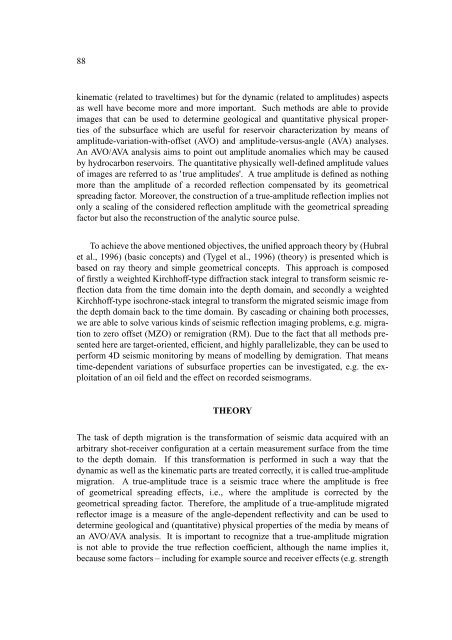Annual Report 2000 - WIT
Annual Report 2000 - WIT
Annual Report 2000 - WIT
You also want an ePaper? Increase the reach of your titles
YUMPU automatically turns print PDFs into web optimized ePapers that Google loves.
88<br />
kinematic (related to traveltimes) but for the dynamic (related to amplitudes) aspects<br />
as well have become more and more important. Such methods are able to provide<br />
images that can be used to determine geological and quantitative physical properties<br />
of the subsurface which are useful for reservoir characterization by means of<br />
amplitude-variation-with-offset (AVO) and amplitude-versus-angle (AVA) analyses.<br />
An AVO/AVA analysis aims to point out amplitude anomalies which may be caused<br />
by hydrocarbon reservoirs. The quantitative physically well-defined amplitude values<br />
of images are referred to as ' true amplitudes'. A true amplitude is defined as nothing<br />
more than the amplitude of a recorded reflection compensated by its geometrical<br />
spreading factor. Moreover, the construction of a true-amplitude reflection implies not<br />
only a scaling of the considered reflection amplitude with the geometrical spreading<br />
factor but also the reconstruction of the analytic source pulse.<br />
To achieve the above mentioned objectives, the unified approach theory by (Hubral<br />
et al., 1996) (basic concepts) and (Tygel et al., 1996) (theory) is presented which is<br />
based on ray theory and simple geometrical concepts. This approach is composed<br />
of firstly a weighted Kirchhoff-type diffraction stack integral to transform seismic reflection<br />
data from the time domain into the depth domain, and secondly a weighted<br />
Kirchhoff-type isochrone-stack integral to transform the migrated seismic image from<br />
the depth domain back to the time domain. By cascading or chaining both processes,<br />
we are able to solve various kinds of seismic reflection imaging problems, e.g. migration<br />
to zero offset (MZO) or remigration (RM). Due to the fact that all methods presented<br />
here are target-oriented, efficient, and highly parallelizable, they can be used to<br />
perform 4D seismic monitoring by means of modelling by demigration. That means<br />
time-dependent variations of subsurface properties can be investigated, e.g. the exploitation<br />
of an oil field and the effect on recorded seismograms.<br />
THEORY<br />
The task of depth migration is the transformation of seismic data acquired with an<br />
arbitrary shot-receiver configuration at a certain measurement surface from the time<br />
to the depth domain. If this transformation is performed in such a way that the<br />
dynamic as well as the kinematic parts are treated correctly, it is called true-amplitude<br />
migration. A true-amplitude trace is a seismic trace where the amplitude is free<br />
of geometrical spreading effects, i.e., where the amplitude is corrected by the<br />
geometrical spreading factor. Therefore, the amplitude of a true-amplitude migrated<br />
reflector image is a measure of the angle-dependent reflectivity and can be used to<br />
determine geological and (quantitative) physical properties of the media by means of<br />
an AVO/AVA analysis. It is important to recognize that a true-amplitude migration<br />
is not able to provide the true reflection coefficient, although the name implies it,<br />
because some factors – including for example source and receiver effects (e.g. strength







